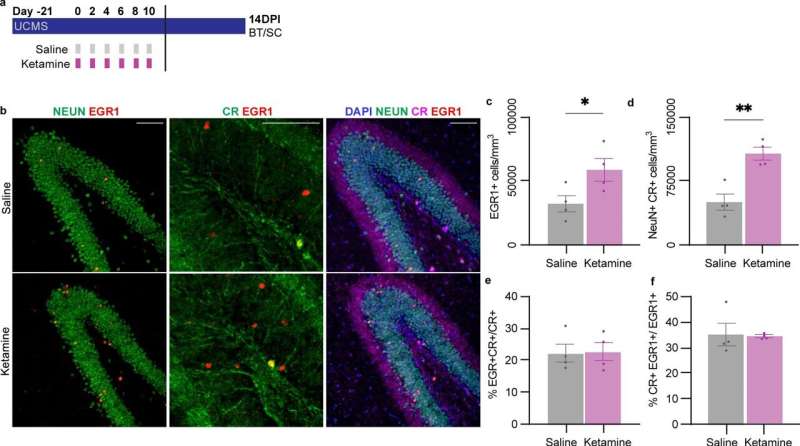This article has been reviewed according to Science X's editorial process and policies. Editors have highlighted the following attributes while ensuring the content's credibility:
fact-checked
trusted source
proofread
Researchers identify mechanism that allow ketamine to act both fast and slow

New treatments for depression are needed that act rapidly and also have sustained effects. Ketamine accomplishes this, but toxic side effects limit its long-term use. Scientists haven't understood how ketamine was able to do both, which hindered drug development.
A new Northwestern Medicine study, published Feb. 27 in Cellular and Molecular Life Sciences, brings that goal one step closer. This work identifies mechanisms that enable ketamine to work rapidly and also have long-term effects.
The short-term and longer-term effects both involve newborn neurons. However, the short-term effects depend upon activity of new neurons that already were born when the drug was taken while the longer-term effects are due to an increased number of newborn neurons that result from the drug.
"This study is exciting because it lays the groundwork for development of non-toxic treatments that exert antidepressant effects within hours like ketamine but that also have the longer-term sustained effects necessary for the treatment of depression," said senior study author Dr. John Kessler, professor of neurology at Northwestern University Feinberg School of Medicine. "This is a tremendous advance for the field."
Ketamine differs from most antidepressants because it produces antidepressant effects within hours instead of weeks like most other medications. This is enormously helpful for patients, potentially reducing their risk of death and suicide in the short term. But the drug's toxic side effects limit its longer-term use.
Corresponding study author Dr. Radhika Rawat, a former research fellow in Kessler's lab and a third-year medical student at Feinberg, had previously discovered that ketamine's ability to produce a rapid antidepressant effect is the result of stimulating activity of newborn neurons, so that they fire more rapidly sending more messages to the rest of the brain.
In Rawat's new study, she investigated two questions: how does the sustained effect of ketamine work and is it different from the rapid effect? She found the sustained effect is, indeed, different. It works by increasing the number of immature cells that have increased activity and firing.
"To make an analogy, think of the young neurons as 'teenagers' who are texting their friends. Increasing the number of text messages spreads information rapidly—that is how ketamine acts rapidly. Increasing the number of teenagers also increases the spread of information, but it takes time for them to be born and mature—that is why there are delayed but longer-term effects."
Rawat also found that the longer-term effects of ketamine occur by acting on the BMP (bone morphogenetic protein) signaling pathway in the hippocampus. The Kessler lab has previously shown that decreased BMP signaling is a common pathway for the action of standard antidepressants. The new study shows this is also true for the sustained effect of ketamine.
"The discovery poses intriguing clinical questions," Rawat said. "Most antidepressants, including SSRIs, reduce BMP signaling. It is worth investigating whether initiating ketamine alongside conventional antidepressants could amplify therapeutic effects."
More information: Radhika Rawat et al, Ketamine's rapid and sustained antidepressant effects are driven by distinct mechanisms, Cellular and Molecular Life Sciences (2024). DOI: 10.1007/s00018-024-05121-6


















